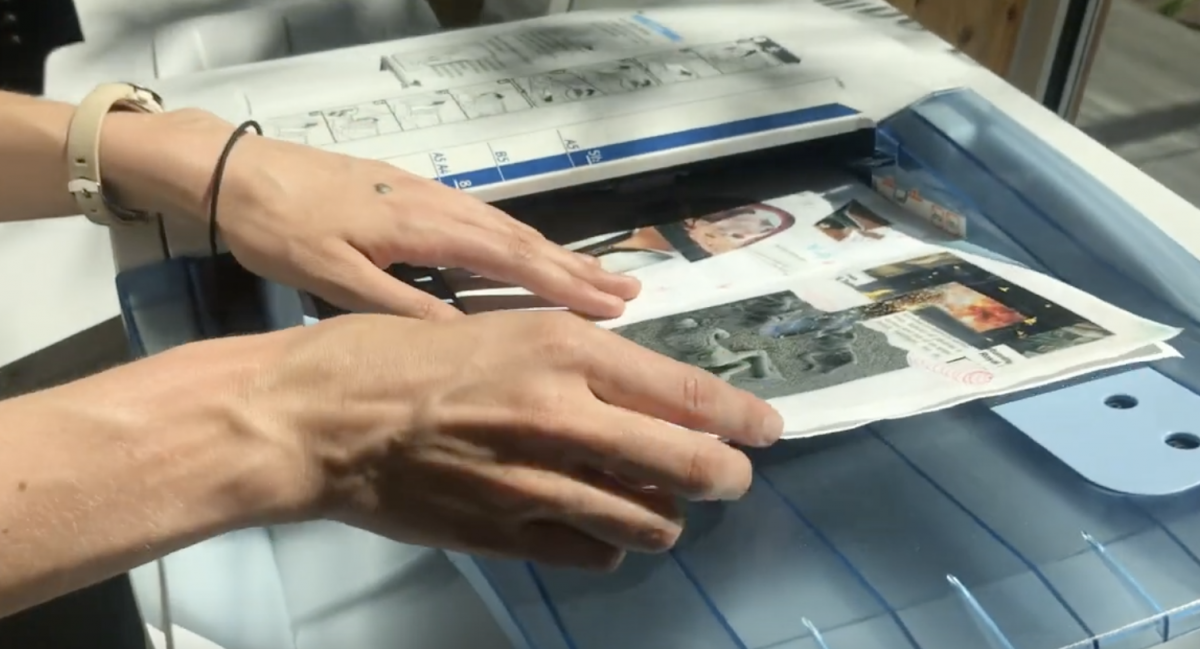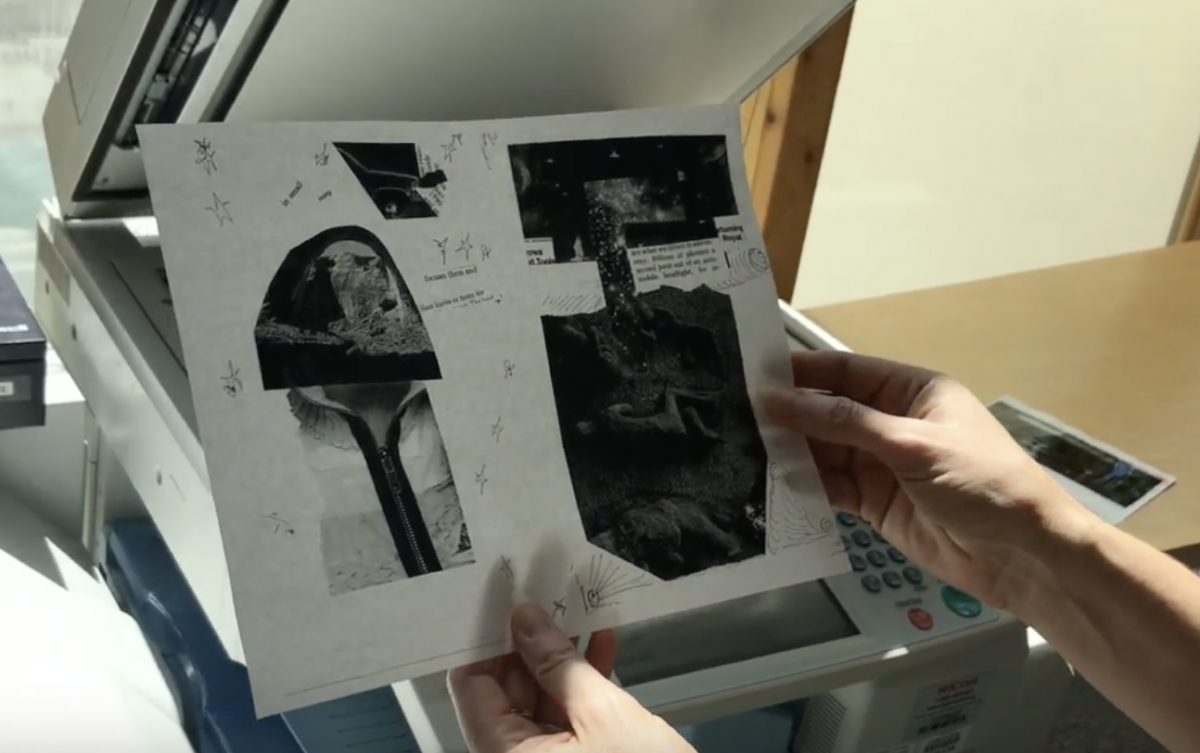The Art of Photocopying
POV: You’re the teaching artist for a pilot zine residency. You’re designing the course, yet you have little experience even making a zine. You’re at the school’s photocopier and a student comes up to you with their finished zine. They look up at you, hoping you can help them photocopy it. You look at the collaged, glued, cut-and-pasted masterpiece they clutch in their hands; you look at the big, scary photocopier. You realize you don’t know how to turn their creation into several copies of a zine.
I found myself in this scenario last spring at City High School while piloting Writing the Community’s first zine residency. In other words, I was lost, panicked, and hoping I didn’t come off as totally unqualified to this poor student.
The Poetry Center asked me to pilot this program because at a professional development meeting several months prior, I divulged that I used to make a music zine with my best friend in early college. However, I dealt with the writing portion of that zine. When it came to the nuts and bolts, the printing and copying, my best friend did the grunt work. Aside from drinking Circle K coffee and stapling zines on their basement floor at one in the morning, I wasn’t involved much in assembling and definitely not in the printing-copying process. Never had I dealt with the challenge of turning an original zine (called a “master flat” in zine lingo) into several copies that could be handed out to friends and family.

You might be wondering: So, what? Isn’t copying a zine just like copying anything else? Well, take the aforementioned student’s zine for example. Her zine was a beautiful collection of textured pages—thick with cut-outs from magazines and globs of Elmer’s glue. Zines like these, in all their collaged glory, cannot be fed directly through the copier without jamming the machine. Simple enough. But the task at hand was to turn this collaged, original zine into a version that could be fed through the copier in order to instantly make dozens of zines at once.
Enter Taylor Johnson, the classroom teacher at City High who I piloted the zine residency with. Taylor, much more experienced at making zines than I, has made several of her own and even perfected a method of copying zines she calls “the shoelace.” Taylor understands the mechanics of zine-making. The photocopier, whilst a mysterious creature to me, is Taylor’s tool.
Back to the moment at the photocopier with the eager student. Taylor came out to the hall and saw me explaining my awkward, convoluted process: “You have to turn these collaged pages into, um…er, a version that you can copy, and then you copy…that?” Taylor put her hand on the photocopier, closed her eyes, and gently offered that there was an easier way and a method of copying that took way less time. Thank goodness for Taylor.
Even better than my explanation, though, is a video that Taylor and I made at the Poetry Center recently. We walk through the steps, demonstrating how to make a pamphlet-style zine on your own. This is the same style of zine we made with students at City High:
Collaboration in the Zine Classroom
As soon as Taylor offered her wisdom, both she and I realized something important: this residency could grow into a collaboration. Instead of me being an expert on all things zine, what about a residency that highlights both our skills and creativity? I was relieved to forego expertise and that the residency no longer felt like mine alone. An opportunity for collaboration felt like a gift. The zine residency was ours.
The best result that came of it? The residency felt collaborative and non-hierarchical for everyone, not just for Taylor and me. Our co-teaching, collaborative style influenced the rest of the class. I overheard amazing conversations. I overheard students asking one another for help editing their zine. I overheard students bouncing ideas off one another and asking, “How do you like this title?” or “Should I include this poem in my zine?” The conversations between students were encouraging as much as they were critical and opinionated.

Is this not how a writing residency—a zine residency in particular—should look? Non-hierarchical and collaborative? Zines are a resistance to hierarchy, after all. No matter how “good” a zine is, its merit is not going to be rewarded by the publishing industry.
Zines also resist the notion of expertise. The golden rules of zine-making, as I see it, are obsession and amateurism. Who cares if someone knows more than you do about the red-eyed tree frog? This doesn’t mean you can’t make a zine about how fascinating you think they are! Who cares if you know nothing about garage rock? This doesn’t mean you and your college friend can’t gush about how much you love Ty Segall in your under-read music zine.
Collaboration makes the amateurism aspect even more fun. The co-editor of your zine might know something about tree frogs that you don’t. Or, your collaborator might have an eye for line edits, but you have the overall vision. Personally, I am so thankful that Taylor had my back and helped with my many blind spots. And I’m grateful that I brought in so many wacky writing prompts and lengthy zine history PowerPoints, and not to mention all my amazing (if I do say so myself) zine-y, riot grrrl playlists.
Both Taylor and I would be remiss if we didn’t acknowledge the incredible work of the students at City High. Their zines are vulnerable, unfiltered, and direct. Lucky for you, their work is slated to appear in the Poetry Center lobby in Spring 2023 and the public will be welcome to peruse.
POV: You’re at the Poetry Center. You see a shelf of amazing zines made by radical, edgy high schoolers and you want to make your own. I’m happy to say there’s any easy way to learn how. Watch our video of Taylor and me showing you how to make a pamphlet-style zine! The steps are detailed in the video making it easy to follow along. We welcome you to join in the collaborative, non-hierarchical, self-publication fun!
Sophie Daws grew up in the Sonoran Desert and her poems revolve around labor, memory, and architecture--all of which are explored in terms of nature/ecology and a feminine-queer aesthetic. Sophie received her B.A. in English Literature and Creative Writing in 2018 and holds a minor in Plant Sciences. She received the Hattie Lockett Award in 2018 and graduated with honors for her poetry manuscript and thesis, Snag.

